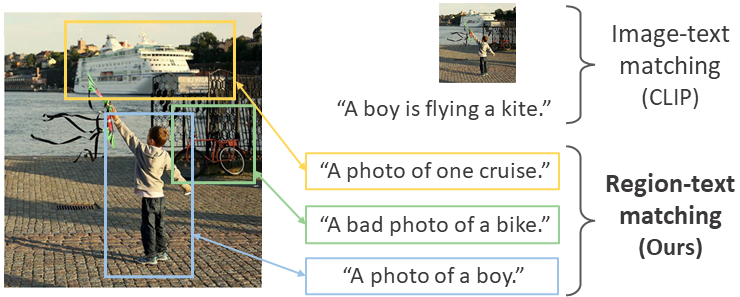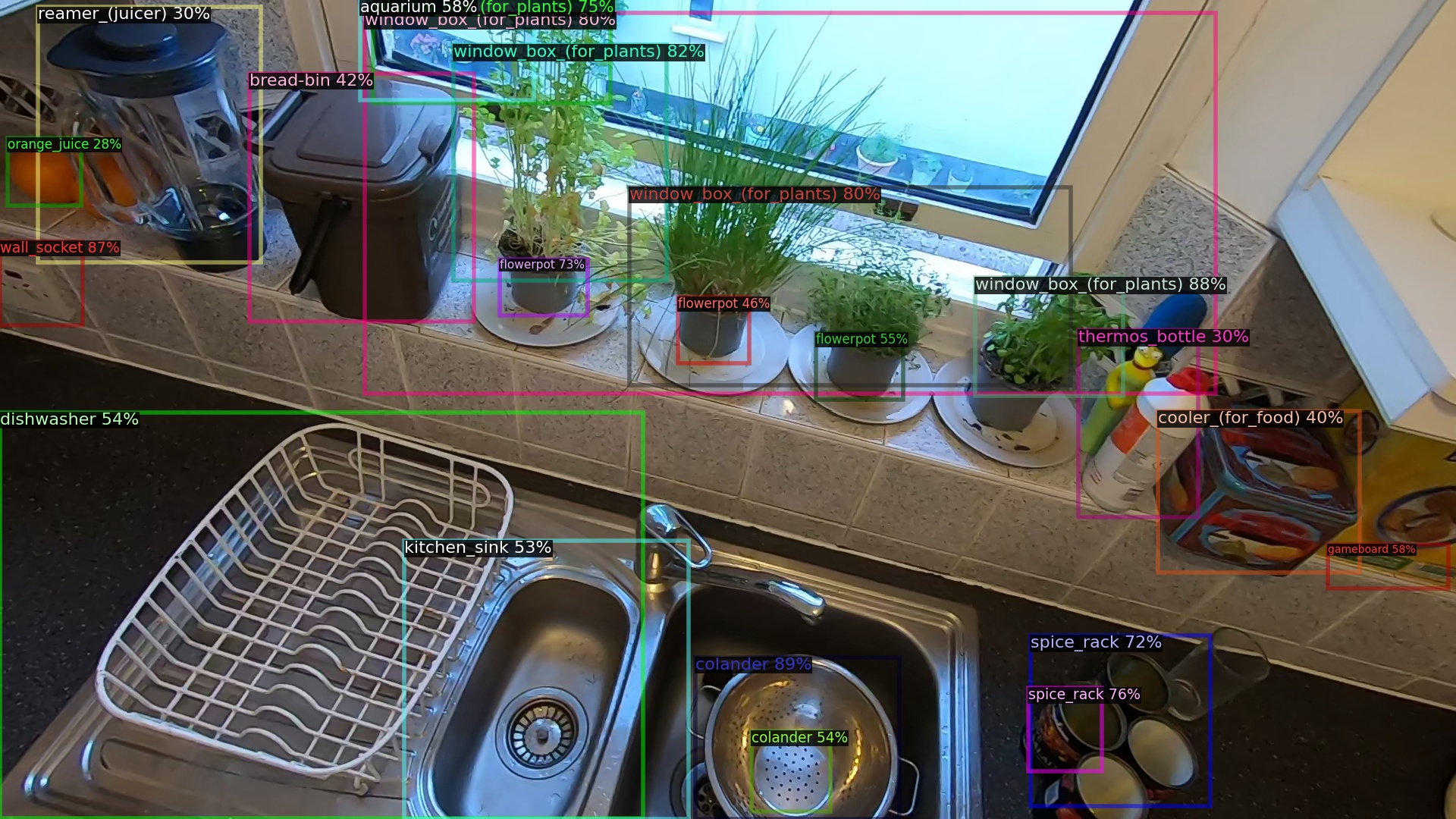This is the official PyTorch implementation of RegionCLIP (CVPR 2022).
RegionCLIP: Region-based Language-Image Pretraining (CVPR 2022)
Yiwu Zhong, Jianwei Yang, Pengchuan Zhang, Chunyuan Li, Noel Codella, Liunian Li, Luowei Zhou, Xiyang Dai, Lu Yuan, Yin Li, and Jianfeng Gao
We propose RegionCLIP that significantly extends CLIP to learn region-level visual representations. RegionCLIP enables fine-grained alignment between image regions and textual concepts, and thus supports region-based reasoning tasks including zero shot object detection and open-vocabulary object detection.
- Pretraining: We leverage a CLIP model to match image regions with template captions, and then pretrain our model to align these region-text pairs.
- Zero-shot inference: Once pretrained, the learned region representations support zero-shot inference for object detection.
- Transfer learning: The learned RegionCLIP model can be further fine-tuned with additional object detection annotations, allowing our model to be used for fully supervised or open-vocabulary object detection.
- Results: Our method demonstrates state-of-the-art results for zero-shot object detection and open vocabulary object detection.
- [06/20/2022] We released models and inference code for our RegionCLIP!
- Installation
- Datasets
- Model Zoo
- Zero-shot Inference
- Transfer Learning
- Extract Region Features
- Citation and Acknowledgement
- Contributing
Check INSTALL.md for installation instructions.
Check datasets/README.md for dataset preparation.
Check MODEL_ZOO.md for our pretrained models.
After pretraining, RegionCLIP can directly support the challenging zero-shot object detection task without finetuning on detection annotation. Given an input image, our pretrained RegionCLIP can match image region features to object concept embeddings, and thus recognize image regions into many object categories. The image regions are produced by a region localizer (e.g., RPN), where the object class names come from a dictionary specifiied by users.
We provide an example below for zero-shot object detection with pretrained RegionCLIP on custom images and for visualizing the results.
Before detecting objects, please prepare pretrained models, label files, and the custom images. See details below.
- Check
MODEL_ZOO.mdto- download the pretrained model checkpoint
regionclip_pretrained-cc_rn50x4.pth(RegionCLIP with ResNet50x4) to the folder./pretrained_ckpt/regionclip. - download the class embeddings
lvis_1203_cls_emb_rn50x4.pthto the folder./pretrained_ckpt/concept_emb/.
- download the pretrained model checkpoint
- Check
datasets/README.mdto download LVIS label filelvis_v1_val.jsonand put it in the folder./datasets/lvis/lvis_v1_val.json. The file is used to specify object class names. - Put all custom images in the folder
./datasets/custom_images/.
After preparation, run the following script to detect objects.
python3 ./tools/train_net.py \
--eval-only \
--num-gpus 1 \
--config-file ./configs/LVISv1-InstanceSegmentation/CLIP_fast_rcnn_R_50_C4_custom_img.yaml \
MODEL.WEIGHTS ./pretrained_ckpt/regionclip/regionclip_pretrained-cc_rn50x4.pth \
MODEL.CLIP.TEXT_EMB_PATH ./pretrained_ckpt/concept_emb/lvis_1203_cls_emb_rn50x4.pth \
MODEL.CLIP.OFFLINE_RPN_CONFIG ./configs/LVISv1-InstanceSegmentation/mask_rcnn_R_50_FPN_1x.yaml \
MODEL.CLIP.TEXT_EMB_DIM 640 \
MODEL.RESNETS.DEPTH 200 \
MODEL.ROI_BOX_HEAD.POOLER_RESOLUTION 18 \
The detection results will be stored as the file "./output/inference/lvis_instances_results.json". To visualize it, run the script below.
python ./tools/visualize_json_results.py \
--input ./output/inference/lvis_instances_results.json \
--output ./output/regions \
--dataset lvis_v1_val_custom_img \
--conf-threshold 0.05 \
--show-unique-boxes \
--max-boxes 25 \
--small-region-px 8100\
The visualized images will be placed at ./output/regions/. The visualized images would look like:
In this example, the detection results come from our pretrained RegionCLIP with ResNet50x4 architecture. The regions are proposed by an RPN trained by 866 object categories from LVIS dataset. For now, we use 1203 object class names from LVIS dataset for this visualization example. We also include an example in visualize_zeroshot_inference.sh with our pretrained RegionCLIP (ResNet50 architecture).
We provide an example below for evaluating our pretrained RegionCLIP (ResNet50) using ground-truth boxes on COCO dataset. This will reproduce our results in Table 4 of the paper.
Before evaluation, please prepare pretrained models and set up the dataset.
- Check
MODEL_ZOO.mdto- download the pretrained RegionCLIP checkpoint
regionclip_pretrained-cc_rn50.pthto the folder./pretrained_ckpt/regionclip. - download the class embeddings
coco_65_cls_emb.pthto the folder./pretrained_ckpt/concept_emb/.
- download the pretrained RegionCLIP checkpoint
- Check
datasets/README.mdto set up COCO dataset.
After preparation, run the following script to evaluate the pretrained model in zero-shot inference setting.
python3 ./tools/train_net.py \
--eval-only \
--num-gpus 1 \
--config-file ./configs/COCO-InstanceSegmentation/CLIP_fast_rcnn_R_50_C4_ovd_zsinf.yaml \
MODEL.WEIGHTS ./pretrained_ckpt/regionclip/regionclip_pretrained-cc_rn50.pth \
MODEL.CLIP.TEXT_EMB_PATH ./pretrained_ckpt/concept_emb/coco_65_cls_emb.pth \
MODEL.CLIP.CROP_REGION_TYPE GT \
MODEL.CLIP.MULTIPLY_RPN_SCORE False \
For more examples, please refer to test_zeroshot_inference.sh. This script covers a wide combination of pretrained models (ResNet50, ResNet50x4), datasets (COCO, LVIS) and region proposal types (ground-truth regions, RPN proposals). Also, please refer to MODEL_ZOO.md for available trained models and datasets/README.md for setting up COCO and LVIS datasets.
Our pretrained RegionCLIP can be further fine-tuned when human annotations of objects are available. In this transfer learning setting, we demonstrate results on open-vocabulary object detection, where the object detector is trained on base categories and evaluated on both base and novel categories.
We show an example for running a trained detector on custom images. Further, we provide scripts of training and evaluation for the benchmark of open-vocabulary object detection, including COCO and LVIS datasets (Table 1 & 2 in paper).
We provide an example below for running a trained open-vocabulary object detector on custom images and for visualizing the results. In this example, the detector is initialized using RegionCLIP (RN50x4), trained on 866 LVIS base categories, and is tasked to detect all 1203 categories on LVIS.
Before detecting objects, please prepare the trained detectors, label files, and the custom images.
- Check
MODEL_ZOO.mdto- download the trained detector checkpoint
regionclip_finetuned-lvis_rn50x4.pthto the folder./pretrained_ckpt/regionclip. - download the trained RPN checkpoint
rpn_lvis_866_lsj.pthto the folder./pretrained_ckpt/rpn. - download the class embeddings
lvis_1203_cls_emb_rn50x4.pthto the folder./pretrained_ckpt/concept_emb/.
- download the trained detector checkpoint
- Check
datasets/README.mdto download label filelvis_v1_val.jsonand put it in the folder./datasets/lvis/lvis_v1_val.json. - Put all custom images in the folder
./datasets/custom_images/.
After preparation, run the following script to detect objects and visualize the results.
# for simplicity, we integrate the script in visualize_transfer_learning.sh
bash visualize_transfer_learning.sh
The visualized images will be placed at ./output/regions/.
We provide an example below for evaluating our open-vocabulary object detector, initialized by RegionCLIP (ResNet50) and trained on COCO dataset.
Before evaluation, please prepare the trained detector and set up the dataset.
- Check
MODEL_ZOO.mdto- download the trained detector checkpoint
regionclip_finetuned-coco_rn50.pthto the folder./pretrained_ckpt/regionclip, - download the trained RPN checkpoint
rpn_coco_48.pthto the folder./pretrained_ckpt/rpn, - download the class embeddings
coco_48_base_cls_emb.pthandcoco_65_cls_emb.pthto the folder./pretrained_ckpt/concept_emb/.
- download the trained detector checkpoint
- Check
datasets/README.mdto set up COCO dataset.
After preparation, run the following script to evaluate the trained open-vocabulary detector.
python3 ./tools/train_net.py \
--eval-only \
--num-gpus 1 \
--config-file ./configs/COCO-InstanceSegmentation/CLIP_fast_rcnn_R_50_C4_ovd.yaml \
MODEL.WEIGHTS ./pretrained_ckpt/regionclip/regionclip_finetuned-coco_rn50.pth \
MODEL.CLIP.OFFLINE_RPN_CONFIG ./configs/COCO-InstanceSegmentation/mask_rcnn_R_50_C4_1x_ovd_FSD.yaml \
MODEL.CLIP.BB_RPN_WEIGHTS ./pretrained_ckpt/rpn/rpn_coco_48.pth \
MODEL.CLIP.TEXT_EMB_PATH ./pretrained_ckpt/concept_emb/coco_48_base_cls_emb.pth \
MODEL.CLIP.OPENSET_TEST_TEXT_EMB_PATH ./pretrained_ckpt/concept_emb/coco_65_cls_emb.pth \
MODEL.ROI_HEADS.SOFT_NMS_ENABLED True \
For more examples, please refer to test_transfer_learning.sh. This script includes benchmark evaluation for various combination of trained detectors (ResNet50, ResNet50x4) and datasets (COCO, LVIS). Also, please refer to MODEL_ZOO.md for available trained models and datasets/README.md for setting up COCO and LVIS datasets.
We provide an example below for training an open-vocabulary object detector on COCO dataset, with pretrained RegionCLIP (ResNet50) as the initialization.
Before training, please prepare our pretrained RegionCLIP model and set up the dataset.
- Check
MODEL_ZOO.mdto- download the pretrained RegionCLIP checkpoint
regionclip_pretrained-cc_rn50.pthto the folder./pretrained_ckpt/regionclip, - download the trained RPN checkpoint
rpn_coco_48.pthto the folder./pretrained_ckpt/rpn, - download the class embeddings
coco_48_base_cls_emb.pthandcoco_65_cls_emb.pthto the folder./pretrained_ckpt/concept_emb/.
- download the pretrained RegionCLIP checkpoint
- Check
datasets/README.mdto set up COCO dataset.
After preparation, run the following script to train an open-vocabulary detector.
python3 ./tools/train_net.py \
--num-gpus 1 \
--config-file ./configs/COCO-InstanceSegmentation/CLIP_fast_rcnn_R_50_C4_ovd.yaml \
MODEL.WEIGHTS ./pretrained_ckpt/regionclip/regionclip_pretrained-cc_rn50.pth \
MODEL.CLIP.OFFLINE_RPN_CONFIG ./configs/COCO-InstanceSegmentation/mask_rcnn_R_50_C4_1x_ovd_FSD.yaml \
MODEL.CLIP.BB_RPN_WEIGHTS ./pretrained_ckpt/rpn/rpn_coco_48.pth \
MODEL.CLIP.TEXT_EMB_PATH ./pretrained_ckpt/concept_emb/coco_48_base_cls_emb.pth \
MODEL.CLIP.OPENSET_TEST_TEXT_EMB_PATH ./pretrained_ckpt/concept_emb/coco_65_cls_emb.pth \
For more examples, please refer to train_transfer_learning.sh. This script provides training scripts for various combination of detector backbones (ResNet50, ResNet50x4) and datasets (COCO, LVIS). Also, please refer to MODEL_ZOO.md for available trained models and datasets/README.md for setting up COCO and LVIS datasets.
Under construction. We're working on scripts for extracting region features from our pretrained models.
If you find this repo useful, please consider citing our paper:
@inproceedings{zhong2022regionclip,
title={Regionclip: Region-based language-image pretraining},
author={Zhong, Yiwu and Yang, Jianwei and Zhang, Pengchuan and Li, Chunyuan and Codella, Noel and Li, Liunian Harold and Zhou, Luowei and Dai, Xiyang and Yuan, Lu and Li, Yin and others},
booktitle={Proceedings of the IEEE/CVF Conference on Computer Vision and Pattern Recognition},
pages={16793--16803},
year={2022}
}
This repository was built on top of Detectron2, CLIP, OVR-CNN, and maskrcnn-benchmark. We thank the effort from our community.
This project welcomes contributions and suggestions. Most contributions require you to agree to a Contributor License Agreement (CLA) declaring that you have the right to, and actually do, grant us the rights to use your contribution. For details, visit https://cla.opensource.microsoft.com.
When you submit a pull request, a CLA bot will automatically determine whether you need to provide a CLA and decorate the PR appropriately (e.g., status check, comment). Simply follow the instructions provided by the bot. You will only need to do this once across all repos using our CLA.
This project has adopted the Microsoft Open Source Code of Conduct. For more information see the Code of Conduct FAQ or contact opencode@microsoft.com with any additional questions or comments.

